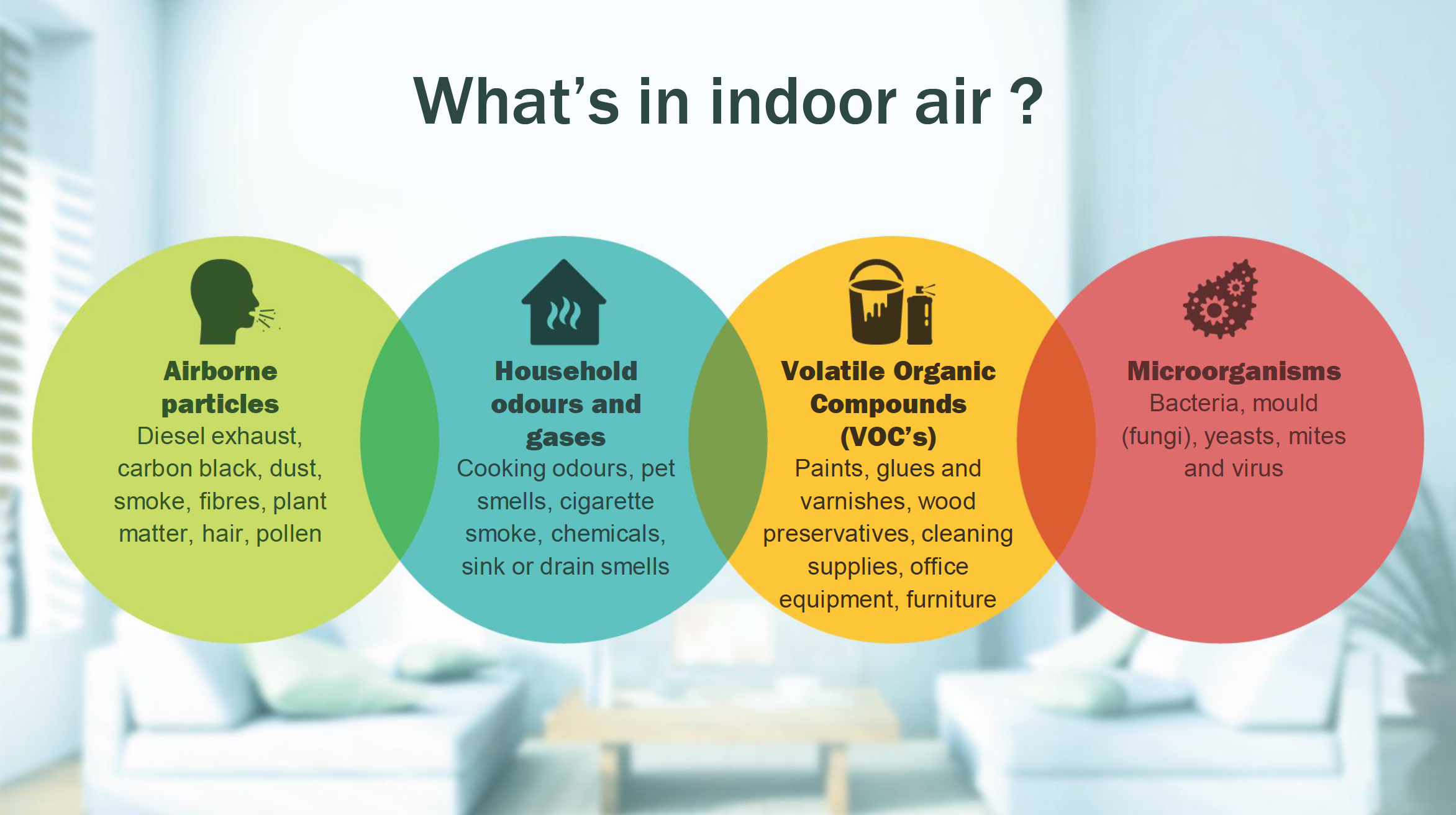
Indoor Air Quality: Impact on Your Health Explained
Indoor air quality (IAQ) is a crucial yet often overlooked aspect of our health and well-being. Many people spend up to 90% of their time indoors, exposing themselves to various pollutants that can have significant health effects. From allergens and dust to harmful chemicals often found in building materials, indoor air pollution can contribute to respiratory issues, fatigue, and even cognitive decline. Fortunately, there are strategies available for improving indoor air quality, ensuring that the spaces we inhabit promote a healthier lifestyle. As we continue to study the link between cognitive function and air quality, it becomes clear that creating healthy buildings is essential for enhancing our daily lives.
The quality of air within enclosed spaces, often referred to as indoor environmental quality, plays a vital role in our overall health. Poorly maintained buildings can become breeding grounds for pollutants that adversely affect physical and mental well-being. Improving the indoor environmental quality through increased ventilation and the use of air filtration systems can help mitigate the risks associated with indoor air contaminants. As our understanding of environmental health evolves, it highlights the importance of designing spaces that foster optimal health and productivity. The interaction between air quality and cognitive function underscores the need to prioritize air cleanliness in our living and working environments.
Understanding Indoor Air Quality
Indoor air quality (IAQ) refers to the condition of the air within buildings, particularly as it relates to the health and comfort of the occupants. Poor IAQ can considerably affect health, leading to a range of symptoms from headaches and fatigue to respiratory issues and cognitive decline. In fact, it has been linked to a rise in indoor air pollution levels, which include pollutants such as mold, dust, volatile organic compounds, and emissions from furniture and building materials.
The importance of monitoring and improving indoor air quality cannot be understated, especially given that individuals spend about 90% of their time indoors. Enhancing IAQ not only supports a healthier living environment but can significantly boost cognitive function and productivity. With the right interventions, such as improving ventilation, reducing contaminants, and using air purification systems, indoor spaces can become healthier, much like the principles of creating healthy buildings.
The Health Effects of Indoor Air Pollution
Indoor air pollution poses a serious risk to health, impacting both physical and mental well-being. Prolonged exposure to pollutants can lead to diseases such as asthma, lung cancer, and other respiratory conditions. Moreover, studies indicate that poor indoor air quality can adversely affect cognitive function, leading to decreased concentration, productivity, and overall mental clarity. This intersection of health and indoor environments highlights the pressing need for homeowners and businesses to address air quality.
The health effects of indoor air quality extend beyond immediate discomfort; they can have long-lasting implications on both physical and cognitive health. Increased levels of carbon dioxide, particulate matter, and biological pollutants can hinder thinking and problem-solving abilities. This is particularly critical in workplaces and schools, where the consequences of diminished cognitive function can translate to lower performance and academic achievement.
Improving Indoor Air Quality: Simple Steps
Improving indoor air quality can be more straightforward than many realize. Simple actions like increasing ventilation, reducing indoor sources of pollution, and utilizing air purifiers or HVAC systems can significantly enhance air quality. For example, regularly opening windows can help dilute indoor pollutants, while using HEPA filters can trap harmful particles from the air. Moreover, maintaining humidity levels can prevent mold growth and dust mite proliferation, two significant contributors to poor IAQ.
Beyond the physical changes, fostering awareness about indoor air quality is crucial for occupants. Informing individuals about potential sources of indoor pollution, such as scented candles, cleaning agents, and furniture material, can empower them to make healthier choices. By implementing a combination of these strategies, any building can be transformed into a healthier, more productive environment.
The Role of Ventilation in Healthy Buildings
Ventilation plays a critical role in maintaining indoor air quality in healthy buildings. Proper ventilation systems are designed to remove indoor air contaminants while introducing clean outdoor air. A study by Harvard highlighted that workplaces with improved ventilation rates not only reduced complaints about air quality but also enhanced workers’ cognitive function, underscoring how vital the flow of air is in support of health.
Additionally, thoughtful ventilation design goes beyond just air exchange; it involves positioning air intakes to minimize the introduction of outdoor pollutants. These systems also need to operate efficiently to ensure energy consumption is balanced with health needs. Overall, effective ventilation strategies are a key component of achieving and sustaining a healthy indoor environment.
Cognitive Function and Air Quality
Research indicates a strong correlation between indoor air quality and cognitive function. For instance, studies have shown that elevated levels of carbon dioxide and particulate matter can negatively impact decision-making, focus, and overall mental agility. In environments where individuals are required to think critically and act decisively, such as in offices and classrooms, ensuring good air quality is imperative for optimal cognitive performance.
Moreover, indoor air pollution is not just a health concern but a productivity issue, especially in workplaces where cognitive function directly correlates to output. Employers who prioritize improving indoor air quality often experience greater employee satisfaction and improved work performance. Therefore, it is crucial to integrate air quality measures within both workplace and educational settings to foster cognitive health and performance.
The Importance of Healthy Building Practices
Healthy building practices focus on creating environments that promote physical and mental well-being for occupants. This entails utilizing materials and construction processes that reduce indoor air pollution, improve air quality, and enhance overall comfort. For instance, selecting low-VOC paints and furnishings can drastically reduce harmful emissions in indoor spaces, creating healthier settings that foster well-being.
Implementing sustainable practices in the design and operation of buildings is essential for maintaining healthy indoor environments. Beyond aesthetics, prioritizing air quality through smart layout designs and integrating green technologies can lead to significant health benefits. As research continues to elucidate the link between indoor environments and health outcomes, healthy building practices will increasingly prove vital for public health and productivity.
Air Quality and Respiratory Health
The impact of indoor air quality on respiratory health is undeniable. Pollutants such as smoke, dust, and allergens can contribute to chronic respiratory conditions, aggravating asthma and increasing the risk of lung infections. Studies have shown that improving indoor air quality can result in lower instances of respiratory diseases and better overall health outcomes for occupants.
Monitoring air quality through regular assessments and implementing proper ventilation strategies can significantly influence respiratory health. Ensuring that buildings are equipped with ventilation systems that regularly exchange stale air for fresh air can help mitigate the accumulation of airborne contaminants, ultimately promoting better respiratory health and reducing the burden of disease within populations.
Preventing Indoor Airborne Illnesses
Indoor air quality plays a crucial role in the prevention of airborne illnesses. High levels of indoor pollutants can facilitate the transmission of viruses and bacteria, leading to outbreaks of illnesses amongst occupants. For example, inadequate ventilation can allow airborne pathogens to linger in the environment for longer periods, increasing the risk of infection.
To combat this, building managers and homeowners should take proactive measures to improve ventilation and utilize air filtration systems. Such practices not only reduce the prevalence of airborne contaminants but also actively contribute to a healthier indoor environment. Actionable steps include increasing outdoor airflow, regularly changing air filters, and using air purifiers to support better air quality and mitigate the spread of illnesses.
The Future of Indoor Air Quality Management
As awareness of indoor air quality’s impact on health grows, so does the emphasis on effective management strategies. Future innovations in building technology are likely to focus on smart sensors and automated systems that continuously monitor air quality, allowing for real-time adjustments to ventilation and air purification. This shift towards technology-driven solutions aims to ensure that indoor environments remain healthy and conducive to occupant well-being.
Moreover, the integration of sustainable practices in air quality management is crucial. This includes leveraging energy-efficient systems that not only improve indoor air quality but also reduce environmental impacts. As cities and communities prioritize public health, adopting forward-thinking approaches to managing indoor air quality will be essential for ensuring healthier living and working environments.
Frequently Asked Questions
What are the health effects of indoor air quality?
Indoor air quality can significantly impact health, with poor air leading to issues like headaches, fatigue, respiratory problems, and even cognitive impairments. Long-term exposure to indoor air pollution can contribute to chronic diseases such as asthma and cardiovascular conditions.
How can I improve indoor air quality in my home?
Improving indoor air quality can be achieved by regularly ventilating your home, using air purifiers with HEPA filters, reducing indoor pollutants (like tobacco smoke or chemical cleaners), and maintaining optimal humidity levels. Plants can also help filter air, contributing to a healthier indoor environment.
What is indoor air pollution and how does it affect cognitive function?
Indoor air pollution includes harmful particles and chemicals that can impair cognitive function and overall well-being. Studies have linked poor indoor air quality to decreased attention, impaired memory, and reduced decision-making abilities, emphasizing the importance of maintaining healthy indoor environments.
What are the key components of a healthy building related to indoor air quality?
Healthy buildings prioritize good indoor air quality through effective ventilation systems, low-emitting materials, regular maintenance, and pollutant sources management. Ensuring good air circulation and using air filtration systems are essential components of these buildings.
How does indoor air quality influence cognitive function and productivity?
Research shows that improved indoor air quality can enhance cognitive function and increase productivity levels. For instance, better ventilation rates can lead to sharper focus and quicker problem-solving abilities, reflecting the crucial role of indoor air quality in workplace efficiency.
| Key Point | Description |
|---|---|
| Indoor Time | Americans spend an average of 80% of their lives indoors. |
| Cognitive Function | Increased air ventilation in buildings has been shown to enhance cognitive function. |
| Ventilation Changes | Ventilation rates altered in the 1970s mainly to limit complaints about body odors. |
| Pollution Sources | Most outdoor air pollution is faced indoors rather than outdoors. |
| Indoor Air Exchange | Up to 30% of indoor air can come from neighboring apartments. |
| Health Opportunities | There are often multiple opportunities to improve building health, possibly over 10. |
| Air Quality Sources | A significant amount of indoor air has just been exhaled by occupants. |
| Infectious Disease Prevention | Bringing in outdoor air and improving filtration can reduce disease spread. |
| Dust Hazards | Dust is hormonally active and can affect health. |
| Chemical Regulations | The EPA has banned only 6 out of over 80,000 commercial chemicals since 1976. |
Summary
Indoor Air Quality is a crucial aspect of our well-being that can significantly impact health. Understanding how we interact with the environments we occupy—whether at home, work, or school—reveals the importance of maintaining good air quality. This knowledge can empower us to take proactive measures to enhance our indoor environments, ultimately contributing positively to our overall health.


